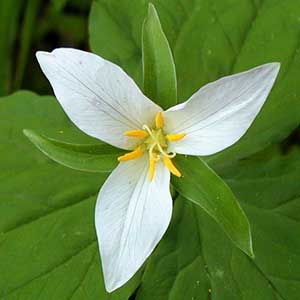Trillium ovatum
Trillium reliquum
Pacific trillium, trillium, western trillium, western wake-robin, western white trillium, white or western trillium, white trillium
confederate wakerobin, relict trillium
semierect to horizontal, short, stout, praemorse.
short, stout, praemorse.
1–2, round, 2–5 dm, ± slender, glabrous.
1–2, semidecumbent, decumbent, or weakly erect (especially in cultivation), S-shaped, round in cross section, 0.6–1.8 dm, glabrous.
sessile, subsessile, or short-petiolate;
blade medium green, sometimes blotched and mottled, main veins prominent, ovate-rhombic, 7–12 × 5–20 cm, continuing to expand during anthesis, base rounded, apex acuminate.
resting on or near ground surface, horizontally spreading, sessile;
blade strongly mottled on each side of central light green stripe in shades of light green, dark green, bronze green, and dark purple, mottling becoming obscure with age, ovate to elliptic, rounded-tapered ± equally from base to tip from widest point, 5–12 × 6–10 cm, apex rounded or weakly acute.
erect or nodding, odorless;
sepals spreading to horizontal, green, lanceolate to oblong-lanceolate, 15–50 × 6–20 mm, margins entire, apex acute;
petals erect-ascending, usually wide-spreading from base, exposing entire pistil, white or with pink or blush markings, lacking V-shaped markings, fading to rosy pink, purple, or dark red, veins not deeply engraved, ± linear to widely obovate, 1.5–7 ×1–4 cm, widest at or above middle, thin-textured, margins flat to undulate, apex acuminate;
stamens prominent, slightly recurved-spreading to straight, 10–18 mm;
filaments white, shorter than anthers, slender;
anthers yellow, 4–16 mm, slender, dehiscence latrorse-introrse;
ovary green or white, ovoid, 6-angled, 5–12 mm, attachment ± 3/4 ovary width;
stigmas recurved, barely connate basally, greenish white or white, linear, not lobed adaxially, 6–10 mm, uniformly thin;
pedicel erect to leaning, 2–6 cm.
borne directly on bracts, odor of putrid meat;
sepals divergent, somewhat recurved, green, maroon streaked, lanceolate, 17–42 × 5–9.5 mm, margins entire, flat, apex rounded-acute;
petals long-lasting, erect, ± connivent, ± concealing stamens and ovary, dark brownish maroon, greenish purple, or streaked with yellow, usually not spirally twisted, narrowly elliptic-lanceolate to oblanceolate, 2.5–5.5 × 0.6–1 cm, thick-textured, margins entire, ± flat, apex acute;
stamens erect, incurved, 12–20 mm;
filaments ± straight, reddish brown, 1–2 mm, slender;
anthers ± straight, dark purple, 4–20 mm, ± thick, dehiscence introrse;
connectives brown-purple, extending 1–2.5 mm beyond anther sacs, apex acute;
ovary green-purple, ovoid, 6-angled, 5–10 mm;
stigmas erect, divergent-recurved, distinct, linear, 2–4 mm, uniformly thin.
baccate, green or white, ± odorless, broadly ovoid, obscurely winged, 1.2–2.8 × 0.7–1.9 cm, pulpy-moist.
baccate, dark maroon-purple, fragrance unreported, ovoid, 6-winged or -angled apically, 0.7–1 cm, pulpy, moist.
= 10.
Trillium ovatum
Trillium reliquum
Varieties 2 (2 in the flora).
(Discussion copyrighted by Flora of North America; reprinted with permission.)
Of conservation concern.
Trillium reliquum recently has been reported from Alabama; I have not seen specimens from there. Otherwise, the species occurs in Clay, Early, and Richmond counties, Georgia, and in Aiken County, South Carolina. It is currently listed as an endangered species in the United States.
(Discussion copyrighted by Flora of North America; reprinted with permission.)
1. Bracts sessile; petals lanceolate to obovate, 1.5–7 × 1–4 cm | var. ovatum |
1. Bracts distinctly short-petiolate; petals linear to linear-lanceolate, 0.5–2.4 × 0.2–0.6 cm | var. oettingeri |
- Local floras:
BC,
CA,
OR,
WA
- Local Web sites:
CalFlora,
CalPhotos,
Flora NW,
PNW Herbaria,
Turner Photog.
WildflowerSearch
iNaturalist (observations)
USDA Plants Database
- LBJ Wildflower Center
- SEINet
- Plants of the World Online
- Encyclopedia of Life
- Wikipedia
- Google Image Search


